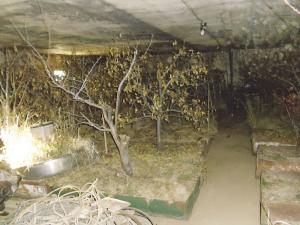2012 - Volume #36, Issue #1, Page #03
[ Sample Stories From This Issue | List of All Stories In This Issue | Print this story
| Read this issue]
Traveling Trees Spend Winter In A Barn
 |
“After the first hard freeze, we move them into the barn with our skid steer,” says Richard. “In early May, we move them back out into the sun.”
The trees’ winter home started out as a confinement hog building with slatted floors. When the Thompsons cut back to just a beef herd, the barn sat empty.
“It’s insulated so even when it was 40 degrees below outside, it’s 16 degrees or better inside the barn,” says Richard.
Avid fruit and vegetable growers, the Thompsons had always wanted to grow fruit not available in the area. Richard wanted to grow his own peaches and thought he might be able to overwinter them in the barn.
After exploring different containers, he settled on splitting old 265-gal. fuel oil barrels lengthwise. He found all he wanted for $10 each.
Drain holes drilled at each end were covered with rock before the bins were filled with rotted manure. Dwarf varieties that don’t get more than 12 ft. high were planted.
Peaches were quickly joined by a wide variety of other fruit trees. At one time the Thompsons had 140 of the tubs as the couple experimented with two of each variety they raised. Some needed a longer growing season or couldn’t handle six months of dormancy in the dark. Others thrived, and the Thompsons kept the ones that did best.
“We have 20 peach trees, 11 apricots, two apricot/plum crosses, three sweet cherry trees, four nectarines, a plum and seven tubs of domesticated blackberries,” says Richard. “We also have 12 tubs of grapes and four tubs of blueberries. Our ten pear trees include nine different varieties.”
While grapes, blueberries and blackberries all grow wild in the area, the varieties in tubs wouldn’t survive unprotected. “The fruit in the tubs are bigger and produce heavily,” he says. “They are zone 5 and would winter-kill here.”
Young trees are anchored by cord to the four corners of the tubs, but after a few years they support themselves. All are kept well pruned so they will fit in the barn with its 7 1/2-ft. ceiling. Blackberries are trellised, as are the grapes.
“Grape tubs have posts at either end and two rails that the vines circle,” he explains. “In the spring I’ll prune them back until it looks like there’s nothing there. By fall you can hardly see to pick the grapes, and we’ll get a 5-gal. pail of grapes from each tub.”
Peach trees and others have to be thinned, too. Richard has discovered the hard way to limit peach trees to around 40 lbs. of fruit. Even so, with as many as 27 peach trees, the fruit produced can be overwhelming.
“One year we had 800 lbs. of peaches, and we canned 500 quarts,” recalls Joyce.
Richard adds that two Bosc pear trees that were the first pears they planted are still producing after 13 years. “One year we picked 72 lbs. off the one and 88 lbs. off the other,” he says. “They were so heavy with fruit that we had to support the limbs with boards.”
The Thompsons sell most of their zone 5 fruit at a local farmers market along with vegetables and other zone 3 apples, currants and berries planted around the farm. Joyce and Richard say the tree-ripened fruit sells itself.
“People will say they don’t like the taste of apricots, and then they sample one of ours and decide they do like them,” says Joyce. “We get a lot of new customers that way.”
Fruit that doesn’t sell fresh is often made into jams and jellies by the Thompson’s daughter, Sheila Cooper. She also sells her canned fruit at the farmers market. However, one peach variety never makes it to the market fresh or preserved.
“The Saturn is the sweetest peach I’ve ever eaten,” says Richard. “It’s donut shaped, and we never sell them. We eat them all ourselves.”
Contact: FARM SHOW Followup, Thompson Farms, RR 2, Box 80, Isle, Minn. 56342 (ph 320 676-3752).

Click here to download page story appeared in.

Click here to read entire issue
To read the rest of this story, download this issue below or click here to register with your account number.




